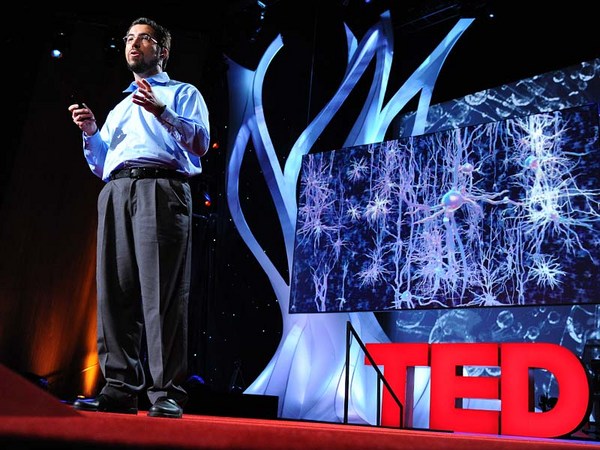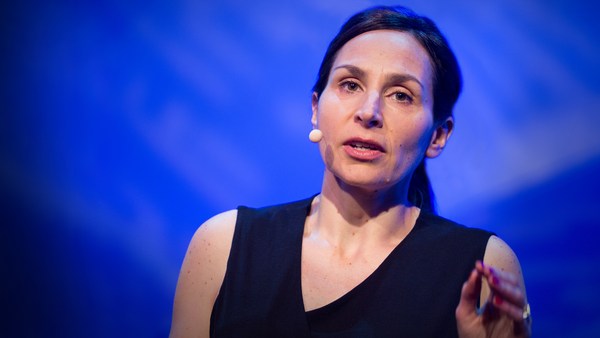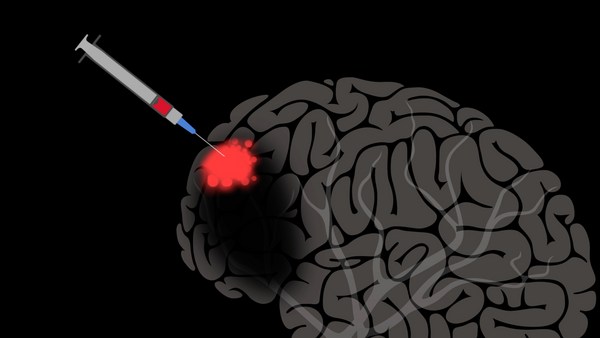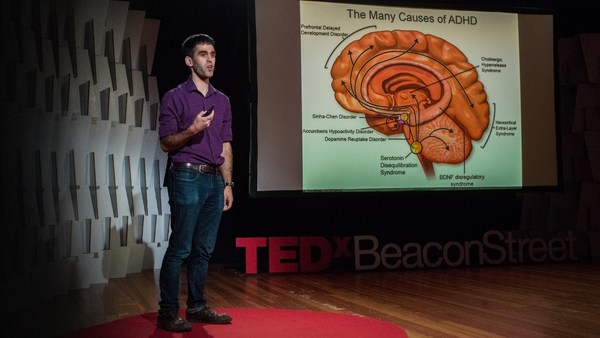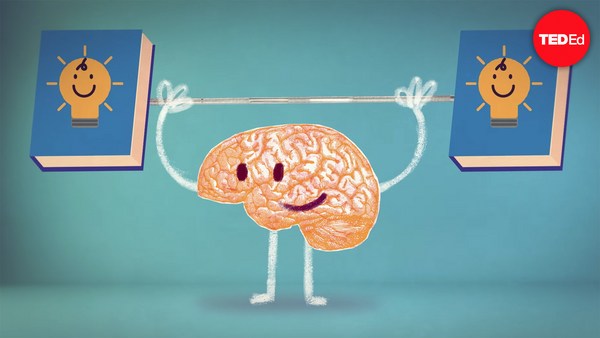Hello, everybody. I brought with me today a baby diaper. You'll see why in a second. Baby diapers have interesting properties. They can swell enormously when you add water to them, an experiment done by millions of kids every day.
(Laughter)
But the reason why is that they're designed in a very clever way. They're made out of a thing called a swellable material. It's a special kind of material that, when you add water, it will swell up enormously, maybe a thousand times in volume. And this is a very useful, industrial kind of polymer. But what we're trying to do in my group at MIT is to figure out if we can do something similar to the brain. Can we make it bigger, big enough that you can peer inside and see all the tiny building blocks, the biomolecules, how they're organized in three dimensions, the structure, the ground truth structure of the brain, if you will? If we could get that, maybe we could have a better understanding of how the brain is organized to yield thoughts and emotions and actions and sensations. Maybe we could try to pinpoint the exact changes in the brain that result in diseases, diseases like Alzheimer's and epilepsy and Parkinson's, for which there are few treatments, much less cures, and for which, very often, we don't know the cause or the origins and what's really causing them to occur. Now, our group at MIT is trying to take a different point of view from the way neuroscience has been done over the last hundred years. We're designers. We're inventors. We're trying to figure out how to build technologies that let us look at and repair the brain. And the reason is, the brain is incredibly, incredibly complicated.
So what we've learned over the first century of neuroscience is that the brain is a very complicated network, made out of very specialized cells called neurons with very complex geometries, and electrical currents will flow through these complexly shaped neurons. Furthermore, neurons are connected in networks. They're connected by little junctions called synapses that exchange chemicals and allow the neurons to talk to each other. The density of the brain is incredible. In a cubic millimeter of your brain, there are about 100,000 of these neurons and maybe a billion of those connections. But it's worse. So, if you could zoom in to a neuron, and, of course, this is just our artist's rendition of it. What you would see are thousands and thousands of kinds of biomolecules, little nanoscale machines organized in complex, 3D patterns, and together they mediate those electrical pulses, those chemical exchanges that allow neurons to work together to generate things like thoughts and feelings and so forth.
Now, we don't know how the neurons in the brain are organized to form networks, and we don't know how the biomolecules are organized within neurons to form these complex, organized machines. If we really want to understand this, we're going to need new technologies. But if we could get such maps, if we could look at the organization of molecules and neurons and neurons and networks, maybe we could really understand how the brain conducts information from sensory regions, mixes it with emotion and feeling, and generates our decisions and actions. Maybe we could pinpoint the exact set of molecular changes that occur in a brain disorder. And once we know how those molecules have changed, whether they've increased in number or changed in pattern, we could use those as targets for new drugs, for new ways of delivering energy into the brain in order to repair the brain computations that are afflicted in patients who suffer from brain disorders.
We've all seen lots of different technologies over the last century to try to confront this. I think we've all seen brain scans taken using MRI machines. These, of course, have the great power that they are noninvasive, they can be used on living human subjects. But also, they're spatially crude. Each of these blobs that you see, or voxels, as they're called, can contain millions and millions of neurons. So it's not at the level of resolution where it can pinpoint the molecular changes that occur or the changes in the wiring of these networks that contributes to our ability to be conscious and powerful beings.
At the other extreme, you have microscopes. Microscopes, of course, will use light to look at little tiny things. For centuries, they've been used to look at things like bacteria. For neuroscience, microscopes are actually how neurons were discovered in the first place, about 130 years ago. But light is fundamentally limited. You can't see individual molecules with a regular old microscope. You can't look at these tiny connections. So if we want to make our ability to see the brain more powerful, to get down to the ground truth structure, we're going to need to have even better technologies.
My group, a couple years ago, started thinking: Why don't we do the opposite? If it's so darn complicated to zoom in to the brain, why can't we make the brain bigger? It initially started with two grad students in my group, Fei Chen and Paul Tillberg. Now many others in my group are helping with this process. We decided to try to figure out if we could take polymers, like the stuff in the baby diaper, and install it physically within the brain. If we could do it just right, and you add water, you can potentially blow the brain up to where you could distinguish those tiny biomolecules from each other. You would see those connections and get maps of the brain. This could potentially be quite dramatic.
We brought a little demo here. We got some purified baby diaper material. It's much easier just to buy it off the Internet than to extract the few grains that actually occur in these diapers. I'm going to put just one teaspoon here of this purified polymer. And here we have some water. What we're going to do is see if this teaspoon of the baby diaper material can increase in size. You're going to see it increase in volume by about a thousandfold before your very eyes. I could pour much more of this in there, but I think you've got the idea that this is a very, very interesting molecule, and if can use it in the right way, we might be able to really zoom in on the brain in a way that you can't do with past technologies.
OK. So a little bit of chemistry now. What's going on in the baby diaper polymer? If you could zoom in, it might look something like what you see on the screen. Polymers are chains of atoms arranged in long, thin lines. The chains are very tiny, about the width of a biomolecule, and these polymers are really dense. They're separated by distances that are around the size of a biomolecule. This is very good because we could potentially move everything apart in the brain. If we add water, what will happen is, this swellable material is going to absorb the water, the polymer chains will move apart from each other, and the entire material is going to become bigger. And because these chains are so tiny and spaced by biomolecular distances, we could potentially blow up the brain and make it big enough to see.
Here's the mystery, then: How do we actually make these polymer chains inside the brain so we can move all the biomolecules apart? If we could do that, maybe we could get ground truth maps of the brain. We could look at the wiring. We can peer inside and see the molecules within. To explain this, we made some animations where we actually look at, in these artist renderings, what biomolecules might look like and how we might separate them. Step one: what we'd have to do, first of all, is attach every biomolecule, shown in brown here, to a little anchor, a little handle. We need to pull the molecules of the brain apart from each other, and to do that, we need to have a little handle that allows those polymers to bind to them and to exert their force.
Now, if you just take baby diaper polymer and dump it on the brain, obviously, it's going to sit there on top. So we need to find a way to make the polymers inside. And this is where we're really lucky. It turns out, you can get the building blocks, monomers, as they're called, and if you let them go into the brain and then trigger the chemical reactions, you can get them to form those long chains, right there inside the brain tissue. They're going to wind their way around biomolecules and between biomolecules, forming those complex webs that will allow you, eventually, to pull apart the molecules from each other. And every time one of those little handles is around, the polymer will bind to the handle, and that's exactly what we need in order to pull the molecules apart from each other.
All right, the moment of truth. We have to treat this specimen with a chemical to kind of loosen up all the molecules from each other, and then, when we add water, that swellable material is going to start absorbing the water, the polymer chains will move apart, but now, the biomolecules will come along for the ride. And much like drawing a picture on a balloon, and then you blow up the balloon, the image is the same, but the ink particles have moved away from each other. And that's what we've been able to do now, but in three dimensions.
There's one last trick. As you can see here, we've color-coded all the biomolecules brown. That's because they all kind of look the same. Biomolecules are made out of the same atoms, but just in different orders. So we need one last thing in order to make them visible. We have to bring in little tags, with glowing dyes that will distinguish them. So one kind of biomolecule might get a blue color. Another kind of biomolecule might get a red color. And so forth. And that's the final step. Now we can look at something like a brain and look at the individual molecules, because we've moved them far apart enough from each other that we can tell them apart.
So the hope here is that we can make the invisible visible. We can turn things that might seem small and obscure and blow them up until they're like constellations of information about life. Here's an actual video of what it might look like. We have here a little brain in a dish -- a little piece of a brain, actually. We've infused the polymer in, and now we're adding water. What you'll see is that, right before your eyes -- this video is sped up about sixtyfold -- this little piece of brain tissue is going to grow. It can increase by a hundredfold or even more in volume. And the cool part is, because those polymers are so tiny, we're separating biomolecules evenly from each other. It's a smooth expansion. We're not losing the configuration of the information. We're just making it easier to see.
So now we can take actual brain circuitry -- here's a piece of the brain involved with, for example, memory -- and we can zoom in. We can start to actually look at how circuits are configured. Maybe someday we could read out a memory. Maybe we could actually look at how circuits are configured to process emotions, how the actual wiring of our brain is organized in order to make us who we are. And of course, we can pinpoint, hopefully, the actual problems in the brain at a molecular level. What if we could actually look into cells in the brain and figure out, wow, here are the 17 molecules that have altered in this brain tissue that has been undergoing epilepsy or changing in Parkinson's disease or otherwise being altered? If we get that systematic list of things that are going wrong, those become our therapeutic targets. We can build drugs that bind those. We can maybe aim energy at different parts of the brain in order to help people with Parkinson's or epilepsy or other conditions that affect over a billion people around the world.
Now, something interesting has been happening. It turns out that throughout biomedicine, there are other problems that expansion might help with. This is an actual biopsy from a human breast cancer patient. It turns out that if you look at cancers, if you look at the immune system, if you look at aging, if you look at development -- all these processes are involving large-scale biological systems. But of course, the problems begin with those little nanoscale molecules, the machines that make the cells and the organs in our body tick. So what we're trying to do now is to figure out if we can actually use this technology to map the building blocks of life in a wide variety of diseases. Can we actually pinpoint the molecular changes in a tumor so that we can actually go after it in a smart way and deliver drugs that might wipe out exactly the cells that we want to?
You know, a lot of medicine is very high risk. Sometimes, it's even guesswork. My hope is we can actually turn what might be a high-risk moon shot into something that's more reliable. If you think about the original moon shot, where they actually landed on the moon, it was based on solid science. We understood gravity; we understood aerodynamics. We knew how to build rockets. The science risk was under control. It was still a great, great feat of engineering. But in medicine, we don't necessarily have all the laws. Do we have all the laws that are analogous to gravity, that are analogous to aerodynamics? I would argue that with technologies like the kinds I'm talking about today, maybe we can actually derive those. We can map the patterns that occur in living systems, and figure out how to overcome the diseases that plague us.
You know, my wife and I have two young kids, and one of my hopes as a bioengineer is to make life better for them than it currently is for us. And my hope is, if we can turn biology and medicine from these high-risk endeavors that are governed by chance and luck, and make them things that we win by skill and hard work, then that would be a great advance.
Thank you very much.
(Applause)
